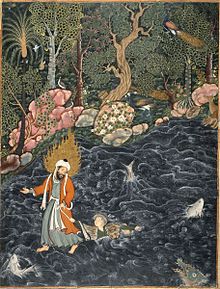Mir Sayyid Ali
Historian and chronicler Qazi Ahmed said that the son was more talented than his father, but the impact of Mir Musavvir did influence his work.Mir Sayyid Ali arrived there in 1549, lived and worked there for as long as the summer of 1555 Humayun's army defeated in a battle the troops of Sikandar Shah.Mir Sayyid Ali, along with Abd al-Samad from childhood had taught the art of drawing to the future sultan, and between them established warm relations.Sayyid Ali headed the imperial court art initiatives, and under his leadership began one of the most ambitious projects in the book of world history – the Akbar Hamzanama, an illustrated copy of the Persian epic of Amir Hamza, the uncle of the prophet Muhammad.Both the heads of the imperial court workshop essentially supervised the work of others, and it is uncertain whether Samad painted any of miniatures himself,[1] though he may have done or corrected much of the underdrawing.But one miniature, "Elijah the prophet rescues drowning Nur ad-Dahr," is credited to Mir Sayyid Ali.Seven years after the start of the large project for a "Hamzanama" that is, approximately in 1569, the artist left the Mughal court, and as a devout Muslim pilgrim went to Mecca.


Los Angeles County Museum of ArtPersianTabrizminiaturePersian miniaturesMughal dynastyMughal paintingMir MusavvirLayla and MajnunShahnameh of Shah TahmaspTahmasp IKhamsa of NizamidiptychShah Tahmasp ISafavid IranMughalHumayunSher Shah SuriShiiteAbd al-SamadSikandar ShahElijahAkbar HamzanamaMuhammadunderdrawingAbu'l-FazlAkbarnamaHamzanamaBritish MuseumHarvard Art Museum